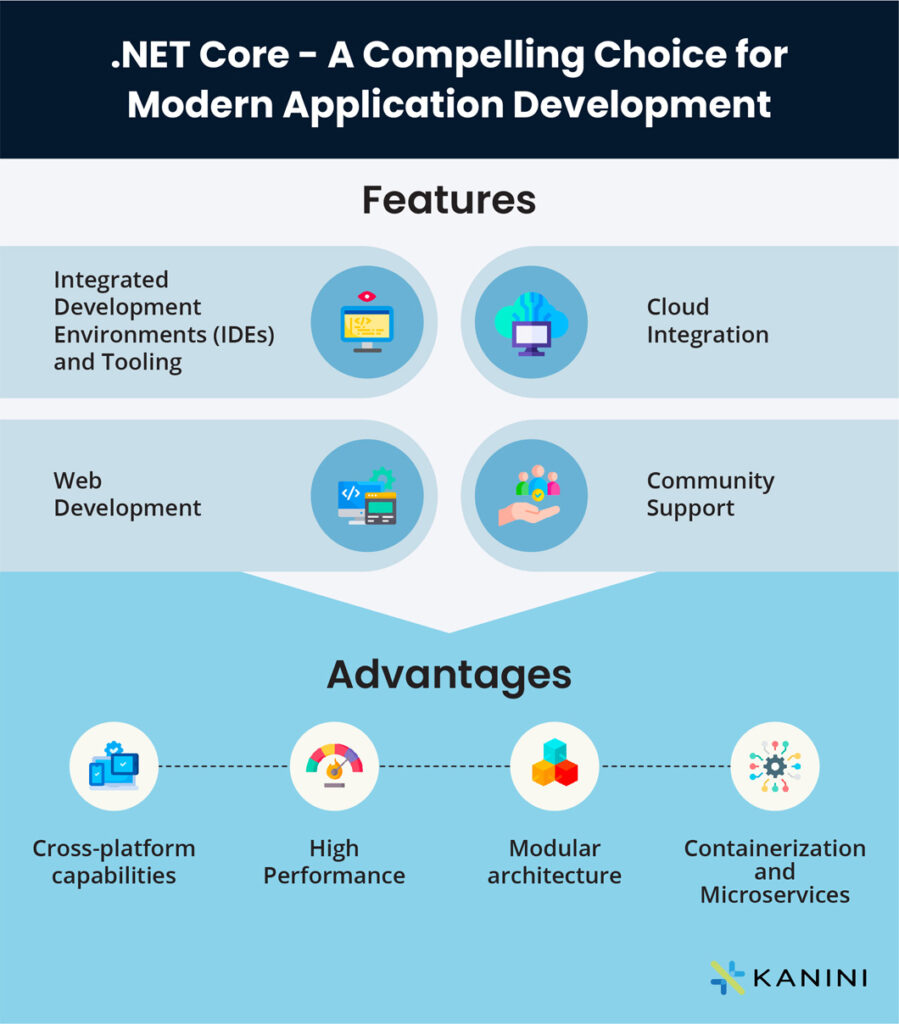.NET Core is a free, open-source, and cross-platform framework developed by Microsoft. It was first introduced in 2016 and has since become a game-changer in the software development landscape. It is now part of a comprehensive .NET platform, from .NET 5 onwards. But why was .NET Core released in the first place when there is .NET Framework already in the market?
As a response to the evolving needs of modern application development, .NET Core was designed to address the limitations of the .NET Framework. It provides a lightweight and modular platform that is designed to be highly dynamic, making it an ideal choice for contemporary software development. In this blog post, we’ll explore the important features of .NET Core and the benefits they manifest for businesses that use it for developing modern applications.
The Key Features That Set .NET Core Apart
.NET Core’s appeal for modern application development lies in the ideal combination of its key features: first, its extensive support for IDEs and tools. Second, its seamless Cloud integration and potent web development capabilities. Third, its thriving community support. Let’s delve deeper into each of these factors.
1. .NET Core Integrated Development Environments (IDEs) and Tooling for Enhanced Application Development
The tools at hand play a key role in developing applications with quality. .NET Core understands this need and integrates into a variety of development environments offering a wide range of options to suit developer preferences.
• Visual Studio and Visual Studio Code: IDE Support
.NET Core’s prowess extends into the space of feature-rich IDEs with support from market stalwarts such as Visual Studio and Visual Studio Code. These IDEs provide an array of features, encompassing intelligent code completion, robust debugging tools, and integration with version control. Visual Studio stands as a testament to an unparalleled development experience, offering an intuitive interface coupled with an extensive suite of tools, as required by modern application development.
• Command-Line Interface (.NET Core CLI): Streamlining Development
For modern developers inclined towards command-line interactions, .NET Core CLI serves as an indispensable companion. This interface presents a diverse set of commands catering to application creation, building, and publication. This command-line approach goes well with developers valuing automation and seeking to embed their workflow within diverse tools and platforms.
• Third-party Tools: Enhancing Development Capabilities
.NET Core’s excellent suite of developer tools such as ReSharper by JetBrains facilitates the building, testing, and implementation of many applications. These tools provide developers with advanced features that include profiling, debugging, unit testing, code completion, and Git integration. This freedom to use third-party developer tools makes it easy for developers to create web applications for ASP.NET Core using their preferred text editors, thereby enhancing flexibility and choice.
2. Cloud Integration and Web Development with .NET Core
Now, let’s delve into how .NET Core integrates with the cloud and allows developers to create agile and scalable web solutions that meet today’s digital demands.
• Azure Integration for Cloud
As the cloud assumes a pivotal role in modern application hosting, .NET Core integrates seamlessly with Microsoft’s Azure services. This integration streamlines the deployment, monitoring, and scaling of applications, enabling developers to direct their focus towards innovation rather than grappling with infrastructure intricacies.
• ASP.NET Core for Web Development
Web development has witnessed a transformation in recent times, necessitating agile and scalable solutions. ASP.NET Core, built atop .NET Core, emerges as the answer to these demands. It furnishes a high-performance runtime for web applications, and its modular architecture helps developers craft tailored APIs and web apps that precisely align with their unique specifications.
• Razor Pages for Web Development
.NET Core’s latest inclusion of Razor Pages enhances its versatility. Razor Pages provides a page-based programming model for creating dynamic web pages, offering a convenient way to blend server-side and client-side code. This integration streamlines the creation of interactive and data-driven web applications, making .NET Core even more appealing for modern web development endeavors.
3. Community Support Makes It an Ideal Choice
The strength of any framework rests upon its community support, and .NET Core revels in the vibrancy of its open-source contributor community. This dynamism translates into a diverse library of packages, sustained enhancements, and a wealth of knowledge dissemination through forums, blogs, and collaborative open-source endeavors, that make the entire application development lifecycle easier for developers.
As we’ve explored the key features that distinguish .NET Core, it’s evident that it is well-equipped to meet the demands of modern application development. Its flexibility, scalability, and wealth of resources can be highly beneficial for businesses using it. Let’s understand these benefits in more detail.

Advantages of .NET Core
Owing to the benefits it brings, developers are turning to .NET Core to build applications that resonate with the needs of modern-day users and meet the highest standards of performance, scalability, and compatibility.
• Cross-Platform Compatibility
Stepping away from the limitations of its predecessor, the traditional .NET Framework, .NET Core liberates developers from platform constraints. It empowers them to create applications that seamlessly operate not only on Windows but also on macOS and a spectrum of Linux distributions.
• High Performance
In modern applications, performance reigns supreme, particularly for applications catering to demanding scenarios such as resource-intensive tasks, complex calculations, or high-demand workloads to meet user expectations. .NET Core catapults itself ahead in this aspect by optimizing its runtime and harnessing the power of Just-In-Time (JIT) compilation. This compilation strategy translates into a faster execution time as the code is converted into native machine code during runtime.
• Modular Architecture
The modularity of .NET Core serves as a strong foundation, giving developers the choice to select and integrate components and libraries with precision. This approach not only trims the application’s overall footprint but also streamlines maintenance efforts. Developers can strategically incorporate only the necessary components, leading to leaner and more manageable codebases.
• Containerization and Microservices
Modern application development thrives on containerization and microservices architecture. .NET Core excels in these areas by offering native support for Docker containers. This compatibility empowers developers to design, deploy, and scale applications consistently across diverse environments. Furthermore, .NET Core’s lightweight nature aligns with the principles of the microservices approach, enabling developers to create and maintain independent, scalable services that can collaborate.
The Way Forward
.NET Core became a part of the comprehensive “.NET” platform since the release of .NET 5 in 2020. Going forward, the latest versions of .NET Core will continue to be included in the Long-term Support (LTS) versions of the .NET platform. .NET 6 is the latest LTS, and .NET 8, which is expected to be released in November 2023, will be the next LTS. These versions establish a bedrock of stability and security, making .NET Core a dependable choice for critical projects that demand a secure and consistent foundation.
If you are looking to unlock the full potential of .NET Core and elevate your application development endeavors, we can help. KANINI is a trusted Microsoft partner, with a wealth of experience in developing durable .NET applications that create new benchmarks in the software development industry. Get in touch with us today and speak with our experts.
Author

Sudheendra Hebbar
Sudheendra is a seasoned Application Architect and works for the Product Engineering Practice at KANINI. He has 17+ years of experience in designing and architecting applications, using Microsoft and Azure technologies, and implementing agile development practices. His focus on a client-centric development approach and proficiency in requirement gathering translates into delivering business value through successful technical solutions.








